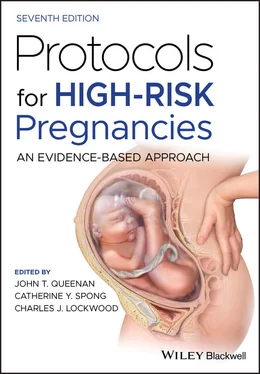When the production of alpha or beta globin is impaired, increasing quantities of variant hemoglobin, such as hemoglobin F or A 2, are produced relative to the production of normal hemoglobin A, causing the variation in disease states described above.
The American College of Obstetricians and Gynecologists recommends initial screening of all populations with a complete blood count. This should be followed by reflex to hemoglobin electrophoresis in the presence of a microcytosis (low mean corpuscular hemoglobin or low mean corpuscular volume) and among individuals of African, Mediterranean, Middle Eastern, Southeast Asian, or Indian descent. Hemoglobin electrophoresis is the gold standard for diagnosis of sickle cell disorders and thalassemias. Solubility tests, isoelectric focusing, and high‐performance liquid chromatography can fail to identify certain hemoglobinopathy traits that can have important reproductive consequences and therefore are generally not used for primary screening.
Beta‐thalassemia will be detected through a hemoglobin constitution of greater than 3.5% hemoglobin A2 and a variably elevated hemoglobin F because beta globin is not present in either of these hemoglobin variants. Alpha‐thalassemia trait may result in a normal hemoglobin electrophoresis and therefore requires diagnosis with DNA‐based testing, which should be pursued in the setting of a low mean corpuscular volume only after iron deficiency anemia and beta‐thalassemia have been excluded and usually after the patient’s partner is also found to be a thalassemia carrier.
Fragile X syndrome
Clinical significance
Fragile X syndrome causes intellectual disability that ranges from mild to severe. It can be associated with autism spectrum disorder and physical anomalies. Affected males tend to have a much more severe phenotype, but females can be affected as well. Premature ovarian failure and fragile X‐associated tremor/ataxia, which causes late onset of Parkinsonism, can affect female and male carriers of fragile X premutation but not intermediate expansion (defined below) respectively. The incidence is 1 in 3600 males and 1 in 5000 females. The carrier frequency depends on family history of developmental delay and ranges from 1 in 86 to 1 in 257.
Most cases of fragile X syndrome are caused by an expansion in the number of CGG repeats in the FMR1 gene. The normal range of repeats is between 5 and 44. Repeat size of 45 to 54 is considered to be of intermediate expansion; 55 to 200 repeats is a premutation; and greater than 200 repeats represents a full mutation. With any number of repeats beyond 44, the region becomes unstable and can lead to expansion during gene replication in oogenesis but generally not spermatogenesis. Hence, a female carrier of CGG repeat number in the premutation range can transmit a full mutation to her offspring. A female carrier of an intermediate expansion, however, can transmit only a premutation but not a full mutation (therefore, risk is assumed by her grandchildren rather than children). A chromosome with a full mutation results in hypermethylation of the DNA, impaired transcription of the downstream FMRP protein, and impaired prenatal and postnatal brain development.
Women with a family history of intellectual disability that is confirmed or suspected to be due to fragile X syndrome are recommended to undergo carrier screening. Although neither ACOG nor ACMG recommends universal screening, guidelines state that it is reasonable to offer carrier screening to any individual requesting screening after appropriate counseling. If a woman is found to carry a premutation or full mutation, diagnostic testing should be offered. Chorionic villus sampling can determine number of CGG repeats but is limited in its ability to determine FMR1 gene methylation; amniocentesis can more reliably determine both repeat number and methylation status.
Tay–Sachs disease and other disorders more prevalent in individuals of Ashkenazi Jewish descent
Clinical significance
Due to founder effects, a number of diseases are more common among individuals of Ashkenazi (Eastern and Central European) Jewish descent. These include Tay–Sachs disease, Canavan disease, familial dysautonomia, Gaucher disease, Fanconi anemia, and a number of other rare disorders. While the clinical manifestations of each of these diseases vary, they have in common severe metabolic, neurologic, or other consequences that lead to early morbidity and mortality. The carrier rates range from 1 in 15 to 1 in 168 for those of Ashkenazi Jewish descent but are typically much rarer in other populations. Tay–Sachs disease specifically is carried by 1 in 30 individuals with Ashkenazi Jewish backgrounds and 1 in 50 individuals of French Canadian, Cajun, and Irish descent.
These conditions are inherited in an autosomal recessive manner. Most are caused by mutations that have been clearly characterized among individuals of Ashkenazi Jewish background but are often uncertain among other populations.
The American College of Obstetricians and Gynecologists recommends that carrier screening for Tay–Sachs disease, Canavan disease, familial dysautonomia, and cystic fibrosis be offered to those of Ashkenazi Jewish ancestry, while the ACMG recommends screening for a panel of nine genetic conditions (see Table 10.1). Expanded screening panels that cover these conditions as well as a broader range of conditions more commonly carried by the Ashkenazi Jewish population are also available. Tay–Sachs screening is also recommended for individuals of French Canadian, Cajun, and Amish backgrounds or those with a family history.
For a couple where one partner is Ashkenazi Jewish, the person of Ashkenazi Jewish background should be tested first. Counseling regarding residual risk should be performed, particularly whenever screening an individual without Ashkenazi Jewish ancestry, due to the potential to be a carrier of a rare mutation.
In the case of screening for Tay–Sachs disease, DNA‐based mutation analysis is highly effective for those in high‐risk populations. However, the serum or leukocyte hexosaminidase enzymatic activity (the enzyme that is deficient in those affected by Tay–Sachs disease) can be used to distinguish carriers from noncarriers in a manner that is not specific to ethnic background. Because it is not mutation specific, biochemical analysis is more sensitive and therefore preferred for screening for Tay–Sachs disease among individuals of nonhigh‐risk ancestry.
Table 10.1 Recommended carrier screening for individuals of Ashkenazi Jewish backgrounds
| American College of Obstetricians and Gynecologists |
American College of Medical Genetics and Genomics |
| Cystic fibrosis |
Cystic fibrosis |
| Tay–Sachs disease |
Tay–Sachs disease |
| Familial dysautonomia |
Familial dysautonomia |
| Canavan disease |
Canavan disease |
|
Fanconi anemia (group C) |
|
Niemann–Pick disease (type A) |
|
Bloom syndrome |
|
Mucolipidosis IV |
|
Gaucher disease |
Carrier screening is optional. It is critical that patient counseling be performed and consent be obtained prior to screening. In the context of expanded panels, for which all conditions cannot be specifically addressed, this education should include a description of the general types of conditions being screened and their common clinical features. Patients should be informed of the potential benefits of acquiring information and the availability of preimplantation genetic diagnosis, donor gametes, prenatal diagnosis and management, coordination of postnatal care, pregnancy termination, and adoption services. There should be a clear process for post‐test counseling and offering of screening to the patient’s reproductive partner or diagnostic testing of the pregnancy in the setting of a positive result. The limitations of carrier screening, including the concept of residual risk and the evolving landscape of expanded panels, should be explained in advance of screening. Efforts should be made to ensure confidentiality of genetic screening results. It is important to note that carrier screening can complement, but does not replace, state‐mandated newborn screening.
Читать дальше












